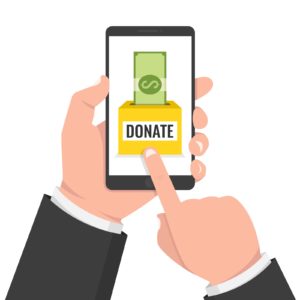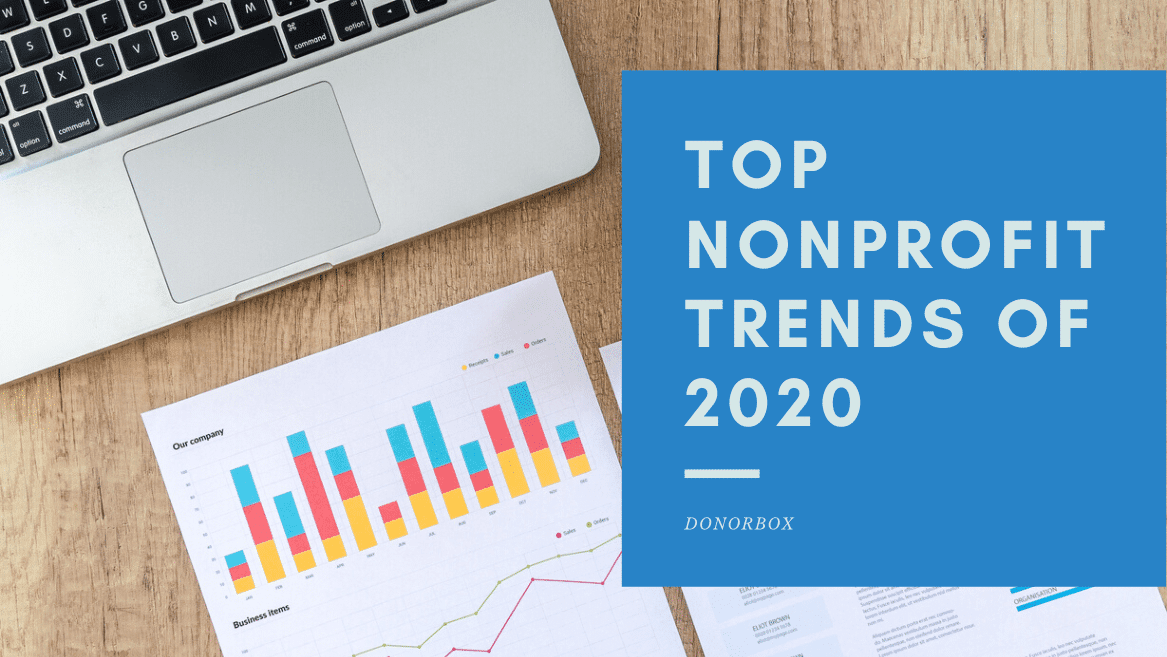The speed at which changes in the nonprofit sector happen can sometimes be so bewildering that it can make your head spin, especially when you have a lot on your plate as a nonprofit professional.
Much of this baffling speed is due to the rapid technological development, and the social and economic shifts that follow suit.
While it can be hard to make time to keep up with these trends (and implementing them is harder still); nonprofits stand to benefit a great deal from doing so.
Digitalization and automation, for example, can help bridge the gap between limited resources (such as overworked staff or shoestring budgets) and their frequently ambitious goals.
We hope that by shining a light on some of the biggest 2020 nonprofit trends, nonprofit professionals and their investors will be equipped with useful information for decision-making and planning.
Understanding what lies ahead can help nonprofit organizations remain at the forefront of their field — which is vital.
Note: Here’s an updated blog post on nonprofit fundraising trends in 2021.
Top Nonprofit Trends for Embracing the Future in 2020.
1. It’s All About That Bass… Oops, We Meant Data
2. Specific Wins Again A.K.A Project-Based Giving
3. Cybersecurity Continues to Matter
4. Give Your Donors a Face and a Name
5. Who’s Doing Your Fundraising?
6. Back With The “Election Effect”
7. Make Giving Ultra Easy
Nonprofit Trend #1: It’s All About That Bass… Oops, We Meant Data

Most nonprofit professionals work really hard. And most nonprofit organizations are doing their best on any given day. Sadly, this doesn’t often translate into tangible results.
Continued advances in artificial intelligence, machine learning, and prescriptive analytics allow nonprofit organizations to make meaning out of mountains of data. This is often called data mining or the process of collecting and analyzing data to determine patterns and trends.
Data mining can be very useful to any nonprofit if properly conducted and acted upon. If you have a robust database of donors and their giving history, you can run reports and see emerging patterns. For example, you can identify major donors in your database that you have somehow been overlooking. You can identify what made your major donors give a large donation for the first time, or you can identify major donor prospects – to name just a few opportunities.
Data mining also allows you to steward a variety of your donor segments efficiently, and to create personalized donor journeys. Through personalization, your nonprofit can deliver better customer experiences, increase donor loyalty, generate measurable ROI and drive more leads.
According to the 2019 Trends In Personalization study, marketers overwhelmingly agree (98%) that personalization helps advance customer relationships, with 70% claiming it has a “strong” or “extremely strong” impact. And 85% state that their customers and prospects expect a personalized experience.
What can you do?
- Have the data in the first place. Good data is essential for successful personalization. Bringing the right data sources together is a constant struggle for marketers across industries.
- Employ machine learning. Among marketers who employ machine learning, 78% described personalization’s impact on customer relationships as “strong” or “extremely strong.
- Collect useful data. For example, which time of the year do you receive most of your donations? What’s your ratio between one-time donors and recurring donors? How are your fundraising campaigns doing?
- Don’t forget about your impact. How are you impacting the world? Start by determining your social impact KPIs and then go from there.
Nonprofit Trend #2: Specific Wins Again A.K.A Project-Based Giving

While donor loyalty is a real thing and while you might have an army of your nonprofit’s brand evangelists (good job!), if you aren’t also exploring project-based fundraising, you could be missing out.
Plenty of donors out there prefer giving to specific projects compared to organizations as a whole. This could especially be relevant if your organization is quite large and runs many different projects.
Giving to a specific project simplifies the process for a donor, making it easy to envision the desired impact of the project, as well as their donation. This is, again, especially the case if your organization is quite large, with an ambitious mission, where a ‘small’ donation might get lost in (at least to the donor’s eyes).
Projects are by definition a finite effort and produce a tangible result. Think of raising money to plant a new city garden or to clean a beach. These are projects. They have a beginning, an ending, and they produce something tangible and visible.
Generally, tangibility is positively correlated with generosity. In other words, when potential donors are given specific information about how their donations will be used, they are more likely to give and to give greater amounts.
What can you do?
- Have a laser-focused goal (as much as possible). Explore creating highly specific campaigns to fulfill clearly defined needs. For example, Charity: water fundraisers are assured that after they finish fundraising they will receive a packet showing exactly where the money they raised has gone.
- Make your projects. That means, make them time-bound. Fundraisers that go on forever won’t cut it. Your outcomes should also be quite tangible.
- Create content. Create content and material specifically for your fundraising campaign/project. For example, create an inspiring video that can incentivize donors to give.
Pro tip: Showcase the impact of a previous project, both on the intended problem/beneficiaries and in terms of better fundraising. For example, if you had run a specific project in Nigeria, speak about how you were able to help “X” number of people.
Nonprofit Trend #3: Cybersecurity Continues to Matter

In the past, cybersecurity and privacy were often low on the list of nonprofit priorities – but times are changing. Cyber threats have never been so prevalent and data privacy issues are very complex. 2020 is THE year to start paying attention to cybersecurity or data protection strategies that meet the evolving needs and challenges of today’s online environment.
If your nonprofit conducts processes donations or event registrations on its website, stores and transfers “personally identifiable information” (Identifiable information include: clients’ medical information; employee or donor records, including drivers’ licenses, addresses, and social security numbers.), or collects information on preferences and habits of donors, patrons, and newsletter subscribers – then cybersecurity needs to become one of your priorities.
Many nonprofits collect and store sensitive personal information that is protected by law as confidential. When there is a breach of the confidentiality of those data, that poses a risk for the individuals whose data was disclosed, and for the nonprofit that will now lose the trust of its donors and potentially be subject to liability for the breach.
What can you do?
- Assess your nonprofit’s data risks. Take inventory of all the data your nonprofit collects and identify where it is stored. Think about the cost/benefit of maintaining all that data. You may find that there is data your nonprofit is currently asking for and keeping that it doesn’t really need.
- Train the staff. Your staff should be aware of how to collect/store/dispose of and protect personally identifiable information. Pay special attention to federal/state/country laws and regulations. For example, in the US, forty-seven states’ laws require nonprofits to inform persons whose “personally identifiable information” is disclosed in a security breach. 31 states have laws that require the disposal of such data in certain ways.
- Establish cybersecurity. Build your cybersecurity governance structure through the development of information security policies and processes to manage your nonprofit’s cybersecurity risk. In particular, you could effectively use in practice VPN and antivirus software. If you are not familiar a lot with VPN and ask what does a VPN do? It will make sure that it provides you with a defense system against external attacks. This should include any applicable legal and regulatory requirements.
Pro tip: Start using a password manager such as LastPass. A password manager saves your passwords and gives you secure access from every computer and mobile device.
Nonprofit Trend #4: Give Your Donors a Face and a Name

If we sound like we’re repeating ourselves with this one, it’s because we are. Personalizing your marketing efforts is probably the single most impactful strategy you can utilize to really get the most out of your fundraising efforts.
People give to people – so enabling them to see a name, a face, and a story will increase the chances of them donating to your cause.
Storytelling is extremely important when connecting with your supporters. What is equally important is making your supporters feel like they are building a personal relationship with your organization.
“Make your story about a specific person (or family or animal) to help people empathize. Make it about the plight of a single person. People are more likely to relate to a story of an abandoned dog than a statistic like “a million dogs are abandoned annually.” Help your audience understand some of the individual, emotional stories that your organization can tell first, and then talk about thousands you helped.”
What can you do?
- Think about how you can use technology. For example, you could experiment with how virtual reality and augmented reality (VR/AR) might help better connect and close the gap between your donors and your beneficiaries, two groups of people that are often worlds apart.
- Explore live streaming. Live streaming is one of the most immediate and authentic tactics you can employ to increase the transparency of your organization. Raw footage could very well be one of your most powerful tools when it comes to giving your donors a face and a name.
- Always think of stories. Collect stories from your employees, board members, volunteers, but especially from those you serve. Share those stories in print, online, on the phone and in person.
Nonprofit Trend #5: Who’s Doing Your Fundraising?

To succeed in the nonprofit world, especially in fundraising, you need to have smart marketing and fundraising strategies. You should be aware of the latest trends that might impact how your nonprofit organization operates. And also have a pretty great website and a solid social media presence. Be equipped with fundraising platforms and donor management systems
But…
If you don’t have a good fundraising team, succeeding will be hard. With all the firefighting that nonprofit professionals need to do on a daily basis, strategically growing the fundraising department (in quantity and quality) can be a real challenge.
Talent acquisition and retention have become an issue for businesses and nonprofit organizations across the world.
For example,
51% of fundraisers said they will leave their current nonprofit within the next two years
30% said they planned to leave fundraising altogether
55% reported often feeling unappreciated
21% agreed that the negative things about their jobs outweighed the positive
(Business2Community.com)
These statistics are startling and worrying.
These ever-changing trends have a direct impact on your mission and the workforce you are working hard to retain. An increasingly transitory workforce is motivated by positive perceptions of the job market and access to seemingly better job options.
What can you do?
- Understand where you stand when it comes to retention. Evaluating where you are and benchmarking your retention practices against those of other nonprofits is a great place to begin. Create a good retention strategy. A good retention strategy doubles as a good recruitment strategy. By creating a reputation as an employer who values their people, you will find that top talent will come to you and save you money on finding them.
- Work hard on your nonprofit culture. Culture is the overarching “feel” including everything from the physical workspace to the behaviors within the organization. (nonprofithr.com). Make sure your organizational values aren’t just words on paper but are a lived experience for your employees.
- Compensate your staff fairly. While this can be tough (with limited budgets and a public perception that often punishes high overhead costs) and while money is not the only factor in employee satisfaction, employees still need to feel like they’re paid fairly.
- Think creatively. A discussion with your own staff may also inspire some creative ideas for nonprofit job benefits and perks (mentorship, volunteer time, discounts, recognition, flexible working hours and telecommuting, etc.) Many of these will require little financial investment but could mean the difference between an employee who is content and one who is looking for employment elsewhere.
Nonprofit Trend #6: Back With The “Election Effect”

Many nonprofit organizations saw a surge in recurring subscription initiations following the 2016 election, particularly civil rights, social action, and advocacy organizations.
As the political climate heats up, individuals are looking for ways to support the causes they care about, especially those that find themselves as the central themes of the political debate.
This trend will, naturally, mostly play out in the US, but likely in other countries too (albeit to a lesser extent) due to the socio-economic power of the United States and the ripple effects US elections have on the rest of the world.
The “Trump bump” and “rage giving” were real trends for many left-leaning advocacy-oriented organizations in 2016, particularly among female donors. And right-leaning organizations ginned up donations in advance of Barack Obama’s election. (rkdgroup.com)
Elections impact donors because donors are (in some sense of the word) activists. They actively support the causes they care about by financially supporting them. Furthermore, you will have to fight for donors’ attention even more than usual. Donors and prospects will receive more mail, emails, targeted ads, phone calls, and text messages in the coming year.
What can you do?
- Pull up your 2016 reports. Go back through your 2016 donor data and see if the 2016 presidential election affected donations leading up to and after election day. See what can you learn from that data. This can help you make better strategic decisions in 2020. Ramp up your donor acquisition and cultivation efforts to strike while the election iron is hot.
- Make sure your recurring giving system is top-notch. A well-established recurring giving program ensures you’re ready to capture surges in support that can occur in the way we saw during the last election year. Recurring donors are 75 percent more likely to make an additional one-time gift within a year than one-time donors.
- Keep a pulse on the news and talk to your donors. Stay aware of what the leading candidates are talking about and how that might relate to your cause. Talk to your donors and ask them if the elections are impacting their giving this year. Both of these can provide valuable information to better position your nonprofit to take advantage of opportunities linked to what’s going on in the political arena.
Nonprofit Trend #7: Make Giving Ultra Easy

The donors of today don’t tolerate slow and laggy websites, complicated giving processes, and weird, difficult-to-read websites. In the age where it takes minutes to buy a new set of forks online, giving needs to be super easy.
A nonprofit that wants to thrive in 2020 must make donating an on-the-go experience.
As technology continues to advance, it has become more important to be aware of all the ways you can make the donation process easier for your donors (not to mention, they’ll start to expect it). Integrated giving is likely going to continue being a nonprofit trend throughout the next 5-10 years. Think of being able to donate by asking Alexa to do so, or to add dollars to their Uber ride to selected nonprofits. Integrated giving will be all about meeting donors where they are and offering simple, fast, and approachable ways for them to get involved.
What can you do?
- Include diverse payment methods. Make sure donors can give via systems like Apple Pay and Google Pay. Make use of accessible services to create apps for your nonprofit.
- Explore website live-chat. Even if you have a lot of information on your website, research shows having a website chat function—either live chat or AI chatbot— is a great way to serve your prospective online donors. In fact, findings from Intercom showed that website visitors are 82% more likely to convert to donors if they’ve chatted with your organization first. A chat function enables the website visitor to ask any question and get a straight-up answer, rather than browsing through a multitude of information. Simply put, it’s easier.
- Add the donate button on social platforms. Recently, Facebook unveiled a digital payment system, called Pay, which lets users make payments across its Messenger, Instagram, and WhatsApp platforms. Your nonprofit can now add a donate button directly to the top of your Instagram profiles.
Pro tip: Use Donorbox and start fundraising with a fast, optimized donation payment system in 15 minutes. Donorbox is a powerful fundraising software that is very simple and fast to set up. It’s optimized for recurring donations with simple and effective checkout and accepts donations in multiple currencies (USD, EUR, CAD, GBP, AUD, plus more) in addition to ApplePay and Google Pay as payment options.
Conclusion
The nonprofit landscape is changing constantly. As your nonprofit progresses into this new decade, it’s never been more vital to understand your nonprofit organization in its cultural and political context. It is important to really “get” your donors. One way to do this is to stay aware of the major forces impacting the world in which we live and work today.
We hope our article helped you learn more about the biggest and most significant fundraising trends in 2020. We also hope you can take these insights on board, applying them to your operations and everyday activities, and getting one step closer to achieving your mission.
Choose Donorbox as your donation system and check out our Nonprofit blog for more nonprofit resources and tips.











